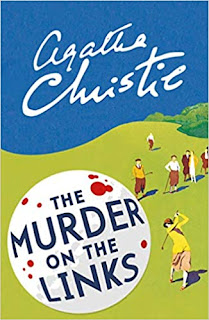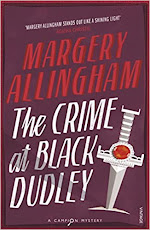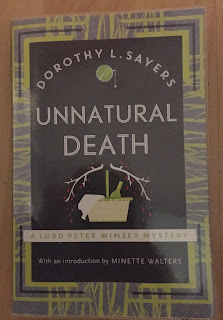Third Campion mystery features an ancient relic, witches, gypsies and a ruthless gang
 |
| Look to the Lady involves Campion searching for a 'monster' hiding in Suffolk woodland |
 |
| Look to the Lady has been republished by Vintage Books |
 |
| Look to the Lady involves Campion searching for a 'monster' hiding in Suffolk woodland |
 |
| Look to the Lady has been republished by Vintage Books |
 |
| No 221B Baker Street, nowadays home to the Sherlock Holmes Museum |
The solution to the mystery of how they first met has been hiding in plain sight all the while, as books usually do, in a slim volume entitled A Study in Scarlet, which I recently found on the shelves of the library where I work.
Written by Arthur Conan Doyle, the story was first published in Beeton’s Christmas Annual in 1887 and introduced the eccentric, amateur detective Holmes and his friend and flatmate, Watson, who always seems to be a couple of steps behind the detective during investigations. They were, of course, destined to become the most famous detective duo ever to appear in fiction.
Watson, in his role of narrator, tells the story of how he first met Holmes. He had been serving as an army doctor in India, but in 1878 he received a bullet in the shoulder at the battle of Maiwand. While recovering from his wound in hospital he contracted enteric fever, from which he almost died.
Watson was sent back to England to convalesce and stays at a small hotel in London. He finds his army pension only just meets his living costs and has just resolved to look for lodgings at a more reasonable price when he encounters an old medical colleague. His former colleague tells him he knows someone in the same situation, who is also looking for modestly priced accommodation to rent in London.. His old colleague then introduces him to Sherlock Holmes, a young man who has been carrying out experiments in the laboratory at the hospital where he works.
 |
| A Study in Scarlet, which explains how Holmes and Watson met |
The title, A Study in Scarlet, is taken from a speech made by Holmes to Watson in which he describes the murder he is currently investigating as his ‘study in scarlet.’ Holmes says: ‘There’s the scarlet thread of murder running through the colourless skein of life, and our duty is to unravel it, and isolate it, and expose every inch of it.’
Holmes, in his capacity as a consulting detective, has been called in by the police to assist with an investigation into the death of a wealthy American, whose body has been found in an empty house.
He takes Dr Watson with him to view the crime scene and, drawing upon his observations, solves the crime and finds the murderer in three days. When Scotland Yard are given all the credit in the newspapers, Watson offers to write up the investigation from the notes in his journal so that the public can learn the truth. He continues to put on record his flatmate's triumphs for subsequent cases, introducing an exciting new genre to English literature.
A Study in Scarlet is believed to be the first work of detective fiction to incorporate the magnifying glass as an investigative tool.
Today marks the anniversary of the death in 1983 of Gladys Mitchell, who was once regarded as one of the top three British women detective writers. 
Gladys Mitchell wrote novels
alongside a career in teaching
She wrote 66 novels featuring her amateur sleuth, Mrs Beatrice Adela Lestrange Bradley, as well as mystery novels under the pen name, Malcolm Torrie, and historical adventure novels under the pen name, Stephen Hockaby.
A teacher by profession, Gladys wrote at least one novel a year throughout her career.
She got off the mark in 1929 with Speedy Death, which introduced Mrs Bradley, and she never looked back, gradually building a large and loyal following for her eccentric, but brilliant, detective.
Gladys was an early member of the Detection Club along with Agatha Christie, G K Chesterton and Dorothy L Sayers, but frequently satirised or reversed the traditional patterns of the genre.
Gladys studied the works of Sigmund Freud and made her series detective, Mrs Bradley, a distinguished psychoanalyst. She also developed an interest in witchcraft, which features in some of her novels.
In 1961, Gladys retired from teaching but continued to write her detective novels. She received the Crime Writers’ Association Silver Dagger in 1976.
 |
| Gladys Mitchell's story, Our Pageant, is included in Serpents in Eden |
Gladys was interested in architecture, ancient buildings, folklore and British customs, themes that were often explored in her novels and short stories.
She originally published many of her short stories in the Evening Standard, but they are now being made available to detective fiction fans again in the anthologies published by the author Martin Edwards for the British Library Crime Classics series.
Our Pageant, a story by Gladys Mitchell first published in the Evening Standard in the 1950s, is included in Serpents in Eden, a volume of countryside crime stories published in 2016.
The story does not feature Mrs Bradley, but it reflects the author’s enthusiasm for British customs. It is very short, only four pages in total, but Gladys makes every word count and there is, of course, a twist at the end. It is well worth the read.
Books by Gladys Mitchell are available fromand
Books by Martin Edwards are available from and
 |
| Agatha Christie's second Poirot novel takes her Belgian detective to the coast of northern France |
The Murder on the Links, Agatha Christie’s third detective novel, was published in March 1923 in the US and in May the same year in the UK, where it was put on sale for seven shillings and sixpence.
It was the second novel to feature Poirot, the little Belgian detective, and his sidekick, Captain Arthur Hastings. They had formed a somewhat unequal sleuthing partnership in The Mysterious Affair at Styles, Agatha’s debut crime novel.
In his second case, Poirot finds himself up against the illustrious Monsieur Giraud, a detective from the Paris Sûretè. Giraud resents Poirot’s involvement in the investigation and will not listen to the experienced Belgian detective’s opinions.
But Poirot knows the case is not all that it seems and looks carefully into the strange circumstances surrounding the murder. He discovers that the motive for the murder is connected to a crime committed more than 20 years before.
Poirot uses his understanding of human nature to help him solve the crime, citing a serial wife killer who used the same method each time, believing that what had once succeeded would succeed again. He says that eventually the killer paid the penalty for his lack of originality!
 |
| The latest reprint of The Murder on the Links |
Having embarked on the mammoth task of reading all Agatha’s 76 detective novels in chronological order, I recently read The Murder on the Links for the second time. It was many years after I had read it for the first time and I expected the novel to seem dated and far simpler than I actually found it to be. I was amazed at how complicated the plot was and how skilfully Agatha encourages the reader to believe one thing, whereas the opposite is in fact the case.
Agatha Christie’s biographer, Laura Thompson, has said of The Murder on the Links: ‘It is very French, not just in setting but in tone, which reeks of Gaston Leroux.’ Agatha had read and been influenced by Leroux’s 1907 novel, The Mystery of the Yellow Room, one of the most celebrated locked room mysteries.
Laura also notes that the book is notable for a subplot in which Hastings falls in love, allowing the author to pack him off to wedded bliss in 'the Argentine', a development that was apparently greatly desired by Agatha.
To the relief of Hastings fans, the author did bring him back from 'the Argentine' from time to time to assist Poirot with his future cases.
The Murder on the Links sees Poirot triumph over his arrogant sleuthing rival, Monsieur Giraud, and gives us a good idea of why the Belgian detective was always to succeed in finding out whodunnit for the next 50 years. I think the novel is well worth reading, or even rereading.
(Picture of French resort by Peter H via Pixabay)
 |
| Sir Arthur Conan Doyle, pictured in 1914, aged 55 |
Conan Doyle left a legacy of 22 novels, including four featuring Sherlock Holmes, and more than 200 short stories, of which 56 told of the exploits of his brilliant detective. In addition, he wrote many non-fiction books, poems, plays and pamphlets.
He had studied medicine and, like his future character Dr Watson, he became a physician. While at the University of Edinburgh medical school, Conan Doyle had been a pupil of the surgeon Joseph Bell, whose deductive processes impressed him so much that he later used him as a model for Holmes.
In 1887, Conan Doyle’s first Sherlock Holmes novel, A Study in Scarlet, was published in Beeton’s Christmas Annual, a compendium published each year from 1860 to 1898. He followed this with a historical novel and an adventure novel. Then in 1890, Spencer Blackett published Conan Doyle’s second Sherlock Holmes novel, The Sign of the Four.
The following year, Conan Doyle began to practice as an oculist - a physician specialising in eye health - in Wimpole Street, just off Harley Street in London. Fortunately for his devoted readers, he had so few patients he decided to write some short stories about Sherlock Holmes for a new monthly magazine, The Strand. These proved so successful he decided to give up medicine and concentrate on writing full time.
Holmes became the world’s most famous fictional detective and inspired the fictional detectives created by hundreds of crime writers who came after Conan Doyle.
 |
| The edition of Beeton's Christmas Annual featuring A Study in Scarlet |
At one stage Conan Doyle became unhappy about the enormous success of his Sherlock Holmes stories eclipsing his more serious historical and romantic novels. He tried to wipe out the great detective at Reichenbach Falls in Switzerland in The Adventure of the Final Problem in 1893, but he was forced to bring Holmes back, following strong public demand, in The Hound of the Baskervilles, published in 1901.
In his later years, Conan Doyle campaigned and wrote about miscarriages of justice and also helped the Government before the First World War by writing recruitment pamphlets.
He also became interested in Spiritualism and wrote about it and lectured about it all over the world. Following a lecture tour of Scandinavia and Holland, he suffered a heart attack in 1929.
Conan Doyle died on 7 July 1930, aged 71. His last book, The Edge of the Unknown, had been published a week earlier. He was buried at Crowborough in East Sussex but his remains were later moved to Minstead Church in the New Forest in Hampshire.
Sir Arthur Conan Doyle’s grave is under a large tree behind the 13th century church of All Saints. The inscription on his tombstone reads:
Steel True
Blade Straight
Arthur Conan Doyle
Knight
Patriot, Physician & Man of Letters
A handy book for anyone wanting to learn more about Sir Arthur Conan Doyle and the Sherlock Holmes stories is The Pocket Essentials: Sherlock Holmes, by Mark Campbell
Sir Arthur Conan Doyle's Sherlock Holmes books are available fromor
 |
| Margery Allingham wrote 18 novels featuring her detective, Albert Campion |
She left a legacy of 18 Albert Campion mysteries, six volumes of short stories featuring the detective and many stand-alone novels, novellas and volumes of short stories. With Agatha Christie, Dorothy L Sayers and Ngaio Marsh she became known as one of the four Queens of Crime.
Margery died of cancer in hospital in Colchester six weeks after her 62nd birthday. She was in the process of writing her last novel, Cargo of Eagles, and had mapped out the story long before her death, so that her husband, Philip Youngman Carter, was able to finish it as she herself would have done, according to her plan.
In a preface to Mr Campion’s Clowns, an omnibus of novels by Margery Allingham, published in 1967, Youngman Carter paid tribute to his late wife as ‘a generous, kind and courageous woman with a rare gift for friendship’.
Margery showed wonderful insight into character and her books abound in witty and accurate observations of people, with an especially keen eye for an eccentric. As she matured as a writer, her books became deeper and started to encompass significant themes, such as love and justice, good and evil, and illusion and truth. Her works have now attained classic status and she has, at times been compared to Charles Dickens and Robert Louis Stevenson
 |
| The Crime at Black Dudley was Allingham's breakthrough |
He was at first thought to be a parody of Sayers’ hero, Lord Peter Wimsey, but Campion matured as the series of books progressed and proved there was a lot more to him, and he became increasingly popular with readers.
Vintage Books, part of the Penguin Random House Group, have now republished all Margery Allingham’s novels featuring her series detective Albert Campion, making it likely that some will eventually be stocked by public libraries.
Margery Allingham's novels are available from or
 |
| Dorothy L Sayers was keen to promote the role of women |
Dorothy went to the Godolphin School in Salisbury, where she won a scholarship to Somerville College in Oxford. She graduated with first class honours in modern languages in 1915 and was one of the first women to be awarded a degree by Oxford University.
She worked for Blackwell’s, the Oxford publishers, and then as a copywriter at Bensons, a London advertising agency.
Dorothy produced her first novel, Whose Body, introducing her amateur detective hero, Lord Peter Wimsey, in 1923. He was to feature in 14 novels and volumes of short stories.
She became a member, and eventually president, of the Detection Club, where she met other crime writers she admired, such as E C Bentley and G K Chesterton.
Dorothy was a keen observer of human nature and was passionate about the education of women and their right to play a positive role in society, as is evident in her third Lord Peter Wimsey novel, Unnatural Death, published in 1927.
 |
| Wimsey was played by Ian Carmichael in the BBC series |
Unnatural Death also broke new ground in that one of the main characters, Mary Whittaker, has been described as the most clearly delineated homosexual character in Golden Age detective fiction, despite the word ‘lesbian’ never being used by the author to describe her.
Mary Whittaker is seen during the novel trying to entice a young girl into a life of homosexuality and, in a scene where Wimsey kisses her, she is shown to be physically revolted by being kissed by a man.
Dorothy also invented an ingenious murder method in the novel, the injection of an air bubble with a hypodermic syringe into the victim, so that there was no obvious cause of death and a post mortem examination would lead to the conclusion that the victim had died of natural causes.
Some critics found fault with this method, while acknowledging it was very cunning. It was believed Dorothy came up with the idea because of her familiarity with motor engines, having had a relationship with a car mechanic and motor bike enthusiast.
She also made use of brand new legislation on inheriting property, introduced in 1925 in England, for the motive for the murder.
Dorothy’s belief that women should be seen to be playing important roles is reflected in her character Miss Katherine Climpson, who she introduces for the first time in Unnatural Causes as a genteel spinster who helps Wimsey with some of his investigations.
 |
| Unnatural Death has been published in a new edition by Hodder |
The novel begins in the most casual way with Lord Peter and his friend, a Scotland Yard detective, Charles Parker, discussing a murder investigation while having dinner in a restaurant and being overheard by a doctor sitting at the next table, who eventually joins them and tells them about the unexpected death of a woman he had been treating.
Lord Peter is convinced the woman has been murdered and, dragging the reluctant Parker along with him, sets out to investigate with no clues to work on. Unnatural Death, a groundbreaking, gripping story, with plenty of twists and turns and some shrewd observations of human nature that even reminded me of Jane Austen, is the fascinating result.
After World War II, Dorothy taught herself old Italian and made a translation of Dante’s Divine Comedy using terza rima, the three-line rhyming scheme that he used in the original . In 1957, while working on Dante’s third volume, Paradiso, Dorothy died of heart failure. Her friend, Dr Barbara Reynolds, completed her work, which she herself had regarded as her greatest achievement.
Unnatural Death was reprinted in 2016 by Hodder and Stoughton and is available from or